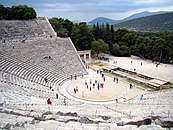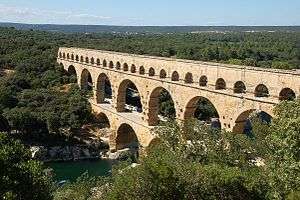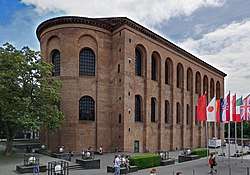Western world
The Western world, also known as the West, refers to various regions, nations and states, depending on the context, most often consisting of the majority of Europe,[lower-alpha 1] Australasia, and most of the Americas.[6][lower-alpha 2] The Western world is also known as the Occident (from the Latin word occidens, "sunset, West"), in contrast to the Orient (from the Latin word oriens, "rise, East"), or Eastern world. It might mean the Northern half of the North–South divide. Western civilization is commonly said to include: Australia, Canada, New Zealand, the United Kingdom, the United States, all European member countries of the EU, EFTA, and European microstates.[8][9]

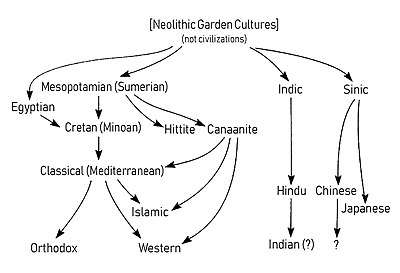
Ancient Greece[lower-alpha 3] and Ancient Rome[lower-alpha 4] are generally considered to be the birthplaces of Western civilization—Greece having heavily influenced Rome—the former due to its impact on philosophy, democracy, science, aesthetics, as well as building designs and proportions and architecture; the latter due to its influence on art, law, warfare, governance, republicanism, engineering and religion. Western civilization is also strongly associated with Christianity, which is in turn shaped by Hellenistic philosophy, Judaism and Roman culture.[10] In the modern era, Western culture has been heavily influenced by the Renaissance, the Ages of Discovery and Enlightenment and the Industrial and Scientific Revolutions.[11][12] Through extensive imperialism, colonialism and Christianization by Western powers in the 15th to 20th centuries, and later exportation of mass culture, much of the rest of the world has been extensively influenced by Western culture, in a phenomenon often called Westernization.
The concept of the Western part of the earth has its roots in the theological, methodological and emphatical division between the Western Roman Catholic and Eastern Orthodox Churches.[13] West was originally literal, opposing Catholic Europe with the cultures and civilizations of Orthodox Europe, the Middle East and North Africa, Sub-Saharan Africa, South Asia, Southeast Asia and East Asia, which early-modern Europeans saw as the East.
By the mid-20th century, Western culture was exported worldwide through the emergent mass media: film, radio, television and recorded music; and the development and growth of international transport and telecommunication (such as transatlantic cable and the radiotelephone) played a decisive role in modern globalization. In modern usage, Western world sometimes[14] refers to Europe and to areas whose populations have had a large European ethnical presence since the 15th century Age of Discovery.[15][16]
Introduction
Western culture was influenced by many older civilizations of the ancient Near East,[17] such as Phoenicia, Ancient Israel,[18][19][10] Minoan Crete, Sumer, Babylonia, and also Ancient Egypt. It originated in the Mediterranean basin and its vicinity; Ancient Greece and Rome are often cited as its birthplaces.
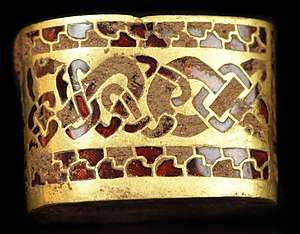
Over time, their associated empires grew first to the east and west to include the rest of Mediterranean and Black Sea coastal areas, conquering and absorbing. Later, they expanded to the north of the Mediterranean Sea to include Western, Central, and Southeastern Europe. Christianization of Ireland (5th century), Christianization of Bulgaria (9th century), Christianization of Kievan Rus' (Russia, Ukraine, Belarus; 10th century), Christianization of Scandinavia (Denmark, Norway, Sweden; 12th century) and Christianization of Lithuania (14th century) brought the rest of present-day European territory into Western civilization.
Historians, such as Carroll Quigley in "The Evolution of Civilizations",[20] contend that Western civilization was born around AD 500, after the total collapse of the Western Roman Empire, leaving a vacuum for new ideas to flourish that were impossible in Classical societies. In either view, between the fall of the Western Roman Empire and the Renaissance, the West (or those regions that would later become the heartland of the culturally "western sphere") experienced a period of first, considerable decline,[21] and then readaptation, reorientation and considerable renewed material, technological and political development. This whole period of roughly a millennium is known as the Middle Ages, its early part forming the "Dark Ages", designations that were created during the Renaissance and reflect the perspective on history, and the self-image, of the latter period.
The knowledge of the ancient Western world was partly preserved during this period due to the survival of the Eastern Roman Empire and the introduction of the Catholic Church; it was also greatly expanded by the Arab importation[22][23] of both the Ancient Greco-Roman and new technology through the Arabs from India and China to Europe.[24][25]
Since the Renaissance, the West evolved beyond the influence of the ancient Greeks and Romans and the Islamic world, due to the successful Second Agricultural, Commercial,[26] Scientific,[27] and Industrial[28] revolutions (propellers of modern banking concepts). The West rose further with the 18th century's Age of Enlightenment and through the Age of Exploration's expansion of peoples of Western and Central European empires, particularly the globe-spanning colonial empires of 18th and 19th centuries.[29] Numerous times, this expansion was accompanied by Catholic missionaries, who attempted to proselytize Christianity.
There is debate among some as to whether Latin America as a whole is in a category of its own.[30] Whether Russia should be categorized as "East" or "West" has been "an ongoing discussion" for centuries.[31]
Western/European culture
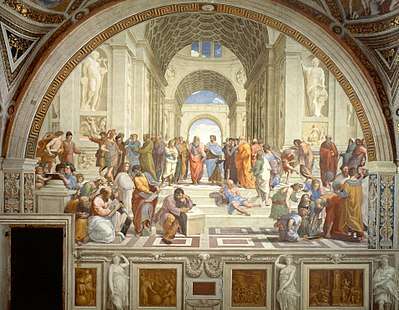
The term "Western culture" is used very broadly to refer to a heritage of social norms, ethical values, traditional customs, religious beliefs, political systems, and specific artifacts and technologies.
Specifically, Western culture may imply:
- a Biblical Christian cultural influence in spiritual thinking, customs and either ethic or moral traditions, around the Post-Classical Era and after.
- European cultural influences concerning artistic, musical, folkloric, ethic and oral traditions, whose themes have been further developed by Romanticism.
- a Graeco-Roman Classical and Renaissance cultural influence, concerning artistic, philosophic, literary, and legal themes and traditions, the cultural social effects of migration period and the heritages of Celtic, Germanic, Slavic and other ethnic groups, as well as a tradition of rationalism in various spheres of life, developed by Hellenistic philosophy, Scholasticism, Renaissance humanism, the Scientific Revolution and Enlightenment.
The concept of Western culture is generally linked to the classical definition of the Western world. In this definition, Western culture is the set of literary, scientific, political, artistic and philosophical principles that set it apart from other civilizations. Much of this set of traditions and knowledge is collected in the Western canon.[32]
The term has come to apply to countries whose history is strongly marked by European immigration or settlement, such as the Americas, and Oceania, and is not restricted to Europe.
Some tendencies that define modern Western societies are the existence of political pluralism, secularism, generalization of middle class, prominent subcultures or countercultures (such as New Age movements), increasing cultural syncretism resulting from globalization and human migration. The modern shape of these societies is strongly based upon the Industrial Revolution and the societies' associated social and environmental problems, such as class and pollution, as well as reactions to them, such as syndicalism and environmentalism.
Historical divisions
The geopolitical divisions in Europe that created a concept of East and West originated in the ancient tyrannical and imperialistic Graeco-Roman times.[13] The Eastern Mediterranean was home to the highly urbanized cultures that had Greek as their common language (owing to the older empire of Alexander the Great and of the Hellenistic successors.), whereas the West was much more rural in its character and more readily adopted Latin as its common language. After the fall of the Western Roman Empire and the beginning of the Medieval times (or Middle Ages), Western and Central Europe were substantially cut off from the East where Byzantine Greek culture and Eastern Christianity became founding influences in the Eastern European world such as the Eastern and Southern Slavic peoples.
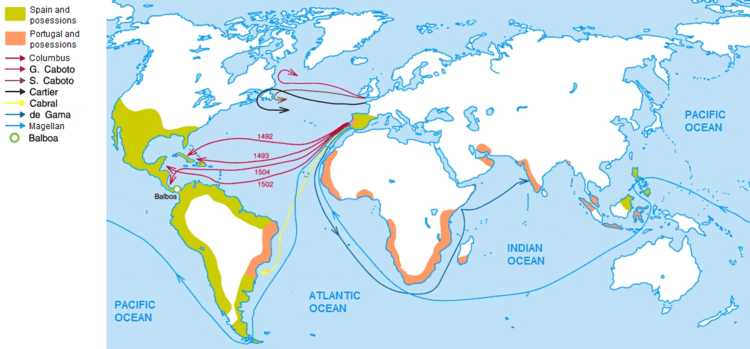
Roman Catholic Western and Central Europe, as such, maintained a distinct identity particularly as it began to redevelop during the Renaissance. Even following the Protestant Reformation, Protestant Europe continued to see itself as more tied to Roman Catholic Europe than other parts of the perceived civilized world. Use of the term West as a specific cultural and geopolitical term developed over the course of the Age of Exploration as Europe spread its culture to other parts of the world. Roman Catholics were the first major religious group to immigrate to the New World, as settlers in the colonies of Portugal and Spain (and later, France) belonged to that faith. English and Dutch colonies, on the other hand, tended to be more religiously diverse. Settlers to these colonies included Anglicans, Dutch Calvinists, English Puritans and other nonconformists, English Catholics, Scottish Presbyterians, French Huguenots, German and Swedish Lutherans, as well as Quakers, Mennonites, Amish, and Moravians.
Ancient Greek-Hellenistic worlds (13th–1st centuries BC)


Ancient Greek civilization had been growing in the first millennium BC into wealthy poleis, so-called city-states (geographically loose political entities which in time, inevitably end giving way to larger organisations of society, including the empire and the nation-state)[33] such as Athens, Sparta, Thebes, and Corinth, by Middle and Near Eastern ones (Sumerian cities such as Uruk and Ur; Ancient Egyptian city-states, such as Thebes and Memphis; the Phoenician Tyre and Sidon; the five Philistine city-states; the Berber city-states of the Garamantes).
The then Hellenic division between the barbarians (term used by Ancient Greeks for all non-Greek-speaking people) and the Greeks contrasted in many societies the Greek-speaking culture of the Greek settlements around the Mediterranean to the surrounding non-Greek cultures. Herodotus considered the Persian Wars of the early 5th century BC a conflict of Europa versus Asia (which he considered all land north and east of the Sea of Marmara, respectively).
The terms "West" and "East" were not used by any Greek author to describe that conflict. The anachronistic application of those terms to that division entails a stark logical contradiction, given that the term "West" has been used to distinguish Latin-speaking peoples from their Greek-speaking neighbors.
Greek culture is said to have influenced Roman civilization in all aspects of society, from architecture to philosophy, art and war.
According to a few writers, the future conquest of parts of the Roman Empire by Germanic peoples and the subsequent dominance by the Western Christian Papacy (which held combined political and spiritual authority, a state of affairs absent from Greek civilization in all its stages), resulted in a rupture of the previously existing ties between the Latin West and Greek thought,[34] including Christian Greek thought.
Ancient Roman world (509 BC–AD 476)
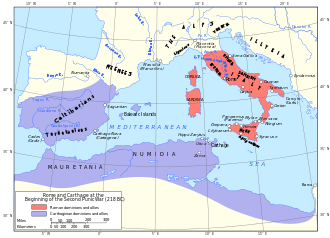
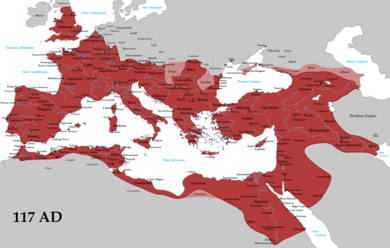
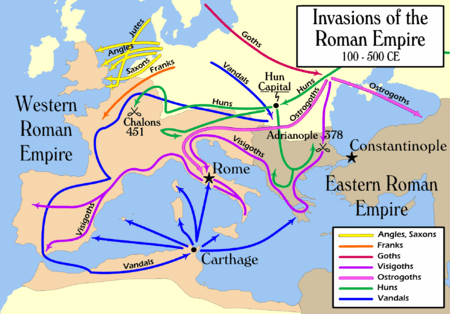
Ancient Rome (753 BC – AD 476) was a civilization that grew from a city-state founded on the Italian Peninsula about the 8th century BC to a massive empire straddling the Mediterranean Sea. In its 10-centuries expansion, Roman civilization shifted from a small monarchy (753 – 509 BC), to a republic (509 – 27 BC), to an autocratic empire (27 BC – AD 476). It came to dominate Western, Central and Southeastern Europe and the entire area surrounding the Mediterranean Sea through conquest using the Roman legions and then through cultural assimilation by eventually giving Roman citizenship privileges to the whole population. Nonetheless, despite its great legacy, a number of factors led to the eventual decline and fall of the Roman Empire.
The Roman Empire succeeded the approximately 500-year-old Roman Republic (c. 510 BC – 30 BC), which had been weakened by the conflict between Gaius Marius and Sulla and the civil war of Julius Caesar against Pompey and Marcus Brutus. During these struggles hundreds of senators were killed, and the Roman Senate had been refilled with loyalists of the First Triumvirate and later those of the Second Triumvirate.[lower-alpha 5] In 350 years, from the successful and deadliest war with the Phoenicians began in 218 BC to the rule of Emperor Hadrian by AD 117, Ancient Rome expanded up to twenty-five times its area. The same time passed before its fall in AD 476. Rome had expanded long before the empire reached its zenith with the conquest of Dacia in AD 106, under Emperor Trajan. During its territorial peak, the Roman Empire controlled about 5,000,000 square kilometres (1,900,000 sq mi) of land surface and had a population of 100 million. From the time of Caesar (100 – 44 BC) to the Fall of the Western Roman Empire, Rome dominated Southern Europe, the Mediterranean coast of Northern Africa and the Western Middle East, including the ancient trade routes with population living outside. Ancient Rome has contributed greatly to the development of law, war, art, literature, architecture, technology and language in the Western world, and its history continues to have a major influence on the world today. Latin language has been the base from which Romance languages evolved and it has been the official language of the Catholic Church and all Catholic religious ceremonies all over Europe until 1967, as well as an or the official language of countries such as Poland (9th–18th centuries).[35]
In AD 395, a few decades before its Western collapse, the Roman Empire formally split into a Western and an Eastern one, each with their own emperors, capitals, and governments, although ostensibly they still belonged to one formal Empire. The Western Roman Empire provinces eventually were replaced by Northern European Germanic ruled kingdoms in the 5th century due to civil wars, corruption, and devastating Germanic invasions from such tribes as the Goths, the Franks and the Vandals by their late expansion throughout Europe. The three-day Visigoths's AD 410 sack of Rome who had been raiding Greece not long before, a shocking time for Graeco-Romans, was the first time after almost 800 years that Rome had fallen to a foreign enemy, and St. Jerome, living in Bethlehem at the time, wrote that "The City which had taken the whole world was itself taken."[36] There followed the sack of AD 455 lasting 14 days, this time conducted by the Vandals, retaining Rome's eternal spirit through the Holy See of Rome (the Latin Church) for centuries to come.[37][38] The ancient Barbarian tribes, often composed of well-trained Roman soldiers paid by Rome to guard the extensive borders, had become militarily sophisticated 'romanized barbarians', and mercilessly slaughtered the Romans conquering their Western territories while looting their possessions.[39]
The Roman Empire is where the idea of "the West" began to emerge. By Rome's central location at the heart of the Empire, "West" and "East" were terms used to denote provinces west and east of the capital itself. Therefore, Iberia (Portugal and Spain), Gaul (France), the Mediterranean coast of North Africa (Tunisia, Algeria, and Morocco) and Britannia were all part of the "West", while Greece, Cyprus, Anatolia, Lebanon, Syria, Israel, Palestine, Egypt, and Libya were part of the "East". Italy itself was considered central, until the reforms of Diocletian dividing the Empire into true two halves: Eastern and Western.
The dissolution of the Western half (nominally in AD 476, but in truth a long process that ended by AD 800) left only the Eastern Roman Empire alive. The East continued to call themselves Eastern Romans even after AD 610 – 800 when the official language of the empire was Latin, and the Pope crowned Charlemagne as Emperor of the Romans. The West began thinking in terms of Western Latins (those living in the old Western Empire) and Eastern Greeks (those inside the Roman remnant to the east).
The Eastern Roman Empire, governed from Constantinople, is usually referred to as the Byzantine Empire after AD 476, the traditional date for the "fall of the Western Roman Empire" and beginning of the Early Middle Ages. The Eastern Roman Empire surviving the fall of the Western protected Roman legal and cultural traditions, combining them with Greek and Christian elements, for another thousand years. The name Byzantine Empire was used after the Byzantine Empire ended, the inhabitants calling themselves Romans since the term “Roman” was meant to signify all Christians.
Middle Ages: Byzantine Empire (AD 395–1450), Holy Roman Empire (AD 800/962–1806), East-West Schism (AD 1054), Protestant Reformation (1500s)
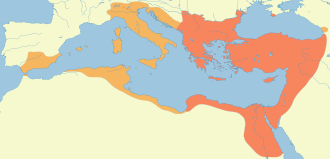
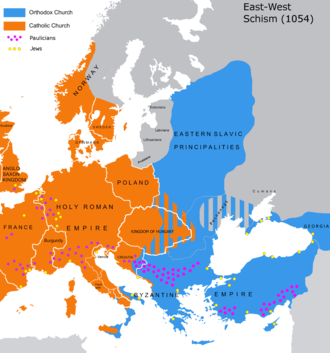
In the early 4th century (AD 330), Roman Emperor Constantine the Great had established the city of Constantinople (formerly ancient Byzantium) as the capital of the Roman Empire, later called "Byzantine Empire" by modern historians. The Eastern Roman Empire included lands south-west of the Black Sea and bordering on the Eastern Mediterranean and parts of the Adriatic Sea. This division into Eastern and Western Roman Empires was reflected in the administration of the Roman Catholic and Eastern Greek Orthodox churches, with Rome and Constantinople debating over whether either city was the capital of Western religion.
As the Eastern (Orthodox) and Western (Catholic) churches spread their influence, the line between Eastern and Western Christianity was moving. Its movement was affected by the influence of the Byzantine empire and the fluctuating power and influence of the Catholic church in Rome. The geographic line of religious division approximately followed a line of cultural divide. The influential American conservative political scientist, adviser and academic Samuel P. Huntington argued that this cultural division still existed during the Cold War as the approximate Western boundary of those countries that were allied with the Soviet Union.[lower-alpha 6]
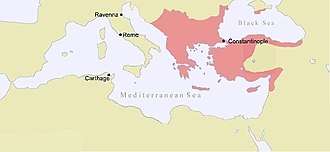
In AD 800 under Charlemagne, the Early Medieval Franks established an empire that was recognized by the Pope in Rome as the Holy Roman Empire (Latin Christian revival of the ancient Roman Empire, under perpetual Germanic rule from AD 962) inheriting ancient Roman Empire's prestige but offending the Roman Emperor in Constantinople. The crowning of the Emperor by the Pope led to the assumption that the highest power was the papal hierarchy, quintessential Roman Empire's spiritual heritage authority, establishing then, until the Protestant Reformation, the civilization of Western Christendom.
The Latin Rite Catholic Church of western and central Europe split with the eastern Greek-speaking Patriarchates in the Christian East–West Schism, also known as the "Great Schism", during the Gregorian Reforms (calling for a more central status of the Roman Catholic Church Institution), three months after Pope Leo IX's death in April 1054.[41] Following the 1054 Great Schism, both the Western Church and Eastern Church continued to consider themselves uniquely orthodox and catholic. Augustine wrote in On True Religion: “Religion is to be sought... only among those who are called Catholic or orthodox Christians, that is, guardians of truth and followers of right.”[42] Over time, the Western Church gradually identified with the "Catholic" label, and people of Western Europe gradually associated the "Orthodox" label with the Eastern Church (although in some languages the "Catholic" label is not necessarily identified with the Western Church). This was in note of the fact that both Catholic and Orthodox were in use as ecclesiastical adjectives as early as the 2nd and 4th centuries respectively. Meanwhile, the extent of both Christendoms expanded, as Germanic peoples, Bohemia, Poland, Hungary, Scandinavia, Baltic peoples, British Isles and the other non-Christian lands of the northwest were converted by the Western Church, while Eastern Slavic peoples, Bulgaria, Serbia, Montenegro, Russian territories, Vlachs and Georgia were converted by the Eastern Church.
In 1071, the Byzantine army was defeated by the Muslim Turco-Persians of medieval Asia, resulting in the loss of most of Asia Minor. The situation was a serious threat to the future of the Eastern Orthodox Byzantine Empire. The Emperor sent a plea to the Pope in Rome to send military aid to restore the lost territories to Christian rule. The result was a series of western European military campaigns into the eastern Mediterranean, known as the Crusades. Unfortunately for the Byzantines, the crusaders (belonging to the members of nobility from France, German territories, the Low countries, England, Italy and Hungary) had no allegiance to the Byzantine Emperor and established their own states in the conquered regions, including the heart of the Byzantine Empire.
The Holy Roman Empire would dissolve on 6 August 1806, after the French Revolution and the creation of the Confederation of the Rhine by Napoleon.
.png)
Decline of the Byzantine Empire (13th–15th centuries) began with the Latin Christian Fourth Crusade in AD 1202–04, considered to be one of the most important events, solidifying the schism between the Christian churches of Greek Byzantine Rite and Latin Roman Rite. An anti-Western riot in 1182 broke out in Constantinople targeting Latins. The extremely wealthy (after previous Crusades) Venetians in particular made a successful attempt to maintain control over the coast of Catholic present-day Croatia (specifically the Dalmatia, a region of interest to the maritime medieval Venetian Republic moneylenders and its rivals, such as the Republic of Genoa) rebelling against the Venetian economic domination.[43] What followed dealt an irrevocable blow to the already weakened Byzantine Empire with the Crusader army's sack of Constantinople in April 1204, capital of the Greek Christian-controlled Byzantine Empire, described as one of the most profitable and disgraceful sacks of a city in history.[44] This paved the way for Muslim conquests in present-day Turkey and the Balkans in the coming centuries (only a handful of the Crusaders followed to the stated destination thereafter, the Holy Land).[lower-alpha 7] The geographical identity of the Balkans is historically known as a crossroads of cultures, a juncture between the Latin and Greek bodies of the Roman Empire, the destination of a massive influx of pagans (meaning "non-Christians") Bulgars and Slavs, an area where Catholic and Orthodox Christianity met,[45] as well as the meeting point between Islam and Christianity. The Papal Inquisition was established in AD 1229 on a permanent basis, run largely by clergymen in Rome,[46] and abolished six centuries later. Before AD 1100, the Catholic Church suppressed what they believed to be heresy, usually through a system of ecclesiastical proscription or imprisonment, but without using torture,[47] and seldom resorting to executions.[48][49][50][51]
This very profitable Central European Fourth Crusade had prompted the 14th century Renaissance (translated as 'Rebirth') of Italian city-states including the Papal States, on eve of the Protestant Reformation and Counter-Reformation (which established the Roman Inquisition to succeed the Medieval Inquisition). There followed the discovery of the American continent, and consequent dissolution of West Christendom as even a theoretical unitary political body, later resulting in the religious Eighty Years War (1568–1648) and Thirty Years War (1618–1648) between various Protestant and Catholic states of the Holy Roman Empire (and emergence of religiously diverse confessions). In this context, the Protestant Reformation (1517) may be viewed as a schism within the Catholic Church. German monk Martin Luther, in the wake of precursors, broke with the pope and with the emperor by the Catholic Church's abusive commercialization of indulgences in the Late Medieval Period, backed by many of the German princes and helped by the development of the printing press, in an attempt to reform corruption within the church.[52][53][54][lower-alpha 8]
Both these religious wars ended with the Peace of Westphalia (1648), which enshrined the concept of the nation-state, and the principle of absolute national sovereignty in international law. As European influence spread across the globe, these Westphalian principles, especially the concept of sovereign states, became central to international law and to the prevailing world order.[55]
Colonial West: discovery of America, mercantilism and imperialism (15th–20th centuries)
Ibrahim Muteferrika, Rational basis for the Politics of Nations (1731)[56]
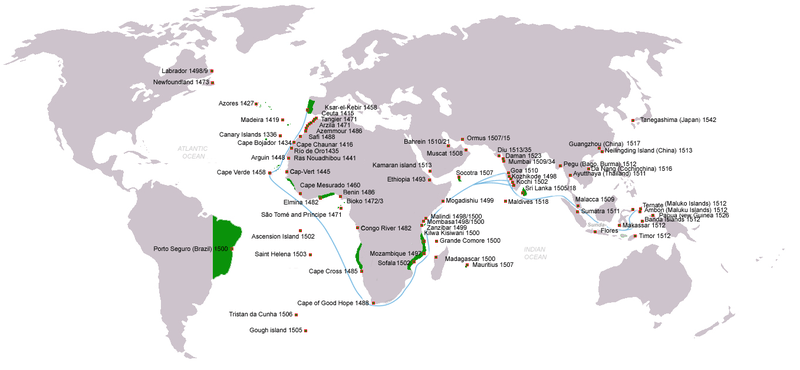
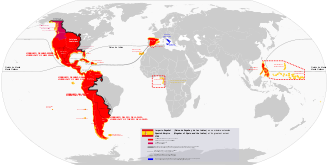
Later concepts of a world of nation-states born by the Peace of Westphalia in 1648, coupled with the ideologies of the Enlightenment, the coming of modernity, the Scientific Revolution[57] and the Industrial Revolution,[58] would produce powerful social transformations, political and economic institutions that have come to influence (or been imposed upon) most nations of the world today. Historians agree that the Industrial Revolution has been one of the most important events in history.[59]
This process of influence (and imposition) began with the voyages of discovery, colonization, conquest, and exploitation of Portugal enforced as well by papal bulls in 1450s (by the fall of the Byzantine Empire), granting Portugal navigation, war and trade monopoly for any newly discovered lands,[60] and competing Spanish navigators. It continued with the rise of the Dutch East India Company by the destabilising Spanish discovery of the New World, and the creation and expansion of the English and French colonial empires, and others.
Due to the reach of these empires, Western institutions expanded throughout the world. Even after demands for self-determination from subject peoples within Western empires were met with decolonization, these institutions persisted. One specific example was the requirement that post-colonial societies were made to form nation-states (in the Western tradition), which often created arbitrary boundaries and borders that did not necessarily represent a whole nation, people, or culture (as in much of Africa), and are often the cause of international conflicts and friction even to this day. Although not part of Western colonization process proper, following the Middle Ages Western culture in fact entered other global-spanning cultures during the colonial 15th–20th centuries.
With the discovery of the American continent or 'New World' in 1492–1493, the European colonial Age of Discovery and exploration was born, revisiting an imperialistic view accompanied by the invention of firearms, while marking the start of the Modern Era. During this long period the Catholic Church launched a major effort to spread Christianity in the New World and to convert the Native Americans and others. A 'Modern West' emerged from the Late Middle Ages (after the Renaissance and fall of Constantinople) as a new civilization greatly influenced by the interpretation of Greek thought preserved in the Byzantine Empire, and transmitted from there by Latin translations and emigration of Greek scholars through Renaissance humanism. (Popular typefaces such as italics were inspired and designed from transcriptions during this period.) Renaissance architectural works, revivals of Classical and Gothic styles, flourished during this modern period throughout Western colonial empires.
Colonialisation by Western/European powers (and others) since 1492.
In the 13th and 14th centuries, a number of European travelers, many of them Christian missionaries, had sought to cultivate trading with Asia and Africa. With the Crusades came the relative contraction of the Orthodox Byzantine's large silk industry in favour of Catholic Western Europe and the rise of Western Papacy. The most famous of these merchant travelers pursuing East–west trade was Venetian Marco Polo. But these journeys had little permanent effect on east–west trade because of a series of political developments in Asia in the last decades of the 14th century, which put an end to further European exploration of Asia: namely the new Ming rulers were found to be unreceptive of religious proselytism by European missionaries and merchants. Meanwhile, the Ottoman Turks consolidated control over the eastern Mediterranean, closing off key overland trade routes.
The Portuguese spearheaded the drive to find oceanic routes that would provide cheaper and easier access to South and East Asian goods, by advancements in maritime technology such as the caravel ship introduced in the mid-1400s. The charting of oceanic routes between East and West began with the unprecedented voyages of Portuguese and Spanish sea captains. In 1492 European colonialism expanded across the globe with the exploring voyage of merchant, navigator, and Hispano-Italian colonizer Christopher Columbus. Such voyages were influenced by medieval European adventurers after the European spice trade with Asia, who had journeyed overland to the Far East contributing to geographical knowledge of parts of the Asian continent. They are of enormous significance in Western history as they marked the beginning of the European exploration, colonization and exploitation of the American continents and their native inhabitants.[lower-alpha 9][lower-alpha 10][lower-alpha 11] The European colonization of the Americas led to the Atlantic slave trade between the 1490s and the 1800s, which also contributed to the development of African intertribal warfare and racist ideology. Before the abolition of its slave trade in 1807, the British Empire alone (which had started colonial efforts in 1578, almost a century after Portuguese and Spanish empires) was responsible for the transportation of 3.5 million African slaves to the Americas, a third of all slaves transported across the Atlantic.[64] The Holy Roman Empire was dissolved in 1806 by the French Revolutionary Wars; abolition of the Roman Catholic Inquisition followed.
In the early-19th century, the systematic urbanisation process (migration from villages in search of jobs in manufacturing centers) had begun, and the concentration of labour into factories led to the rise in the population of the towns. World population had been rising as well. It is estimated to have first reached one billion in 1804.[65] Also, the new philosophical movement later known as Romanticism originated, in the wake of the previous Age of Reason of the 1600s and the Enlightenment of 1700s. These are seen as fostering the 19th century Western world's sustained economic development.[66]
 Parliament building, Portugal (1598–1938)
Parliament building, Portugal (1598–1938) Parliament building, Italy (1653-1927)
Parliament building, Italy (1653-1927)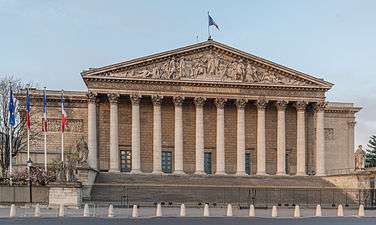 Parliament building, France (1722–26)
Parliament building, France (1722–26) Former Parliament building, Ireland (1729–96)
Former Parliament building, Ireland (1729–96) Parliament building, United States (1783-1800)
Parliament building, United States (1783-1800)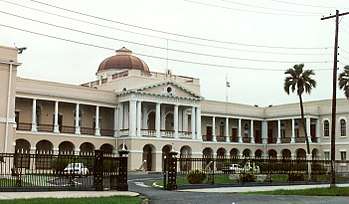 Parliament building, Guyana (1829-1834)
Parliament building, Guyana (1829-1834)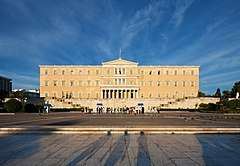 Parliament building, Greece (1836–43)
Parliament building, Greece (1836–43)- Parliament building, United Kingdom (1840–76)
_14.jpg) Parliament building, Spain (1843–50)
Parliament building, Spain (1843–50)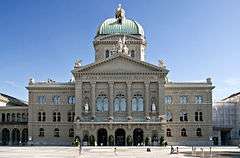 Parliament building, Switzerland (1852-1902)
Parliament building, Switzerland (1852-1902)- Parliament building, Chile (1857-1876)
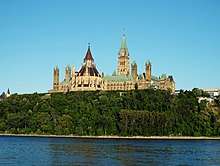 Parliament building, Canada (1859–1927)
Parliament building, Canada (1859–1927) Parliament building, Austria (1874–83)
Parliament building, Austria (1874–83).jpg) Parliament building, South Africa (1875–84)
Parliament building, South Africa (1875–84) Parliament building, Colombia (1876-1926)
Parliament building, Colombia (1876-1926) Parliament building, Belgium (1879–83)
Parliament building, Belgium (1879–83) Parliament building, Germany (1884–94)
Parliament building, Germany (1884–94) Parliament building, Argentina (1896-1906)
Parliament building, Argentina (1896-1906) Parliament building, Sweden (1897-1905)
Parliament building, Sweden (1897-1905)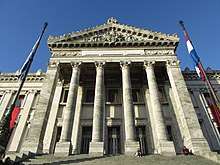 Parliament building, Uruguay (1905-1924)
Parliament building, Uruguay (1905-1924)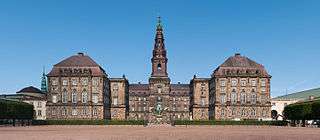 Parliament building, Denmark (1907–28)
Parliament building, Denmark (1907–28) Parliament building, Mexico (1909-1911)
Parliament building, Mexico (1909-1911).jpg) Parliament building, Brazil (1922-1926)
Parliament building, Brazil (1922-1926) Parliament building, Cuba (1926-1929)
Parliament building, Cuba (1926-1929)- Parliament building, Guatemala (1926-1934)
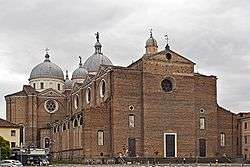 Abbey of Santa Giustina, Italy (1501–1606)
Abbey of Santa Giustina, Italy (1501–1606)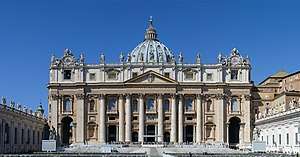 St. Peter's Basilica, Vatican City (1506-1626)
St. Peter's Basilica, Vatican City (1506-1626).jpg) St Paul's Cathedral, United Kingdom (1677-1708)
St Paul's Cathedral, United Kingdom (1677-1708).jpg) Basilica-Cathedral of Our Lady of the Pillar, Spain (1681–1872)
Basilica-Cathedral of Our Lady of the Pillar, Spain (1681–1872)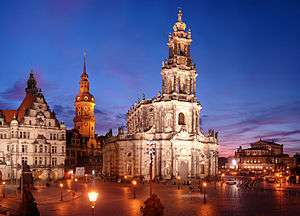 Dresden Cathedral, Germany (1739–55)
Dresden Cathedral, Germany (1739–55)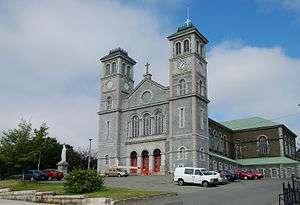 Basilica of St. John the Baptist, Canada (1839–55)
Basilica of St. John the Baptist, Canada (1839–55)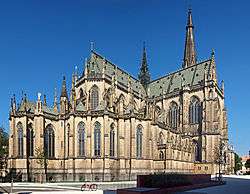 New Cathedral, Austria (1862-1924)
New Cathedral, Austria (1862-1924)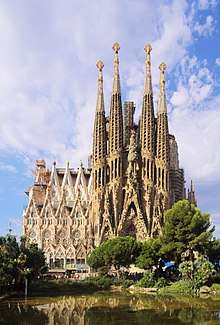 Sagrada Família, Spain (1882–present)
Sagrada Família, Spain (1882–present)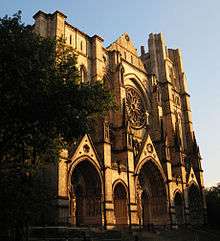 Cathedral of Saint John the Divine, United States (1892–present)
Cathedral of Saint John the Divine, United States (1892–present)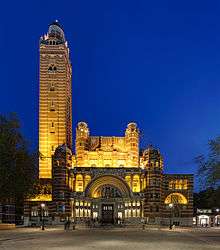 Westminster Cathedral, United Kingdom (1895–1910)
Westminster Cathedral, United Kingdom (1895–1910)
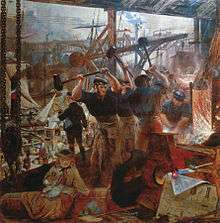
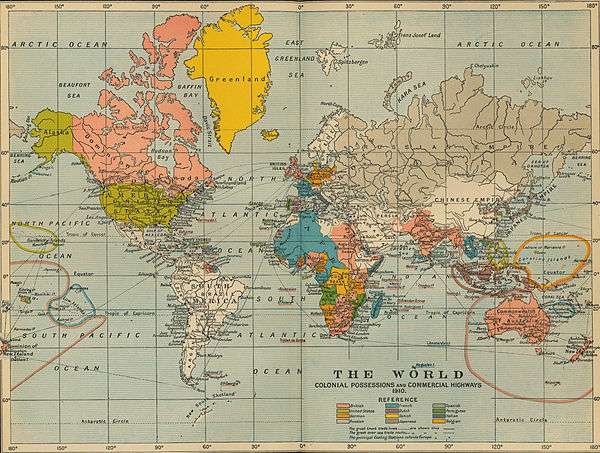
Before the urbanisation and industrialization of the 1800s, demand for oriental goods such as porcelain, silk, spices and tea remained the driving force behind European imperialism in Asia, and (with the important exception of British East India Company rule in India) the European stake in Asia remained confined largely to trading stations and strategic outposts necessary to protect trade.[67] Industrialisation, however, dramatically increased European demand for Asian raw materials; and the severe Long Depression of the 1870s provoked a scramble for new markets for European industrial products and financial services in Africa, the Americas, Eastern Europe, and especially in Asia (Western powers exploited their advantages in China for example by the Opium Wars).[68] This resulted in the so-called "New Imperialism", which saw a shift in focus from trade and indirect rule to formal colonial control of vast overseas territories ruled as political extensions of their mother countries.[lower-alpha 12] The later years of the 19th century saw the transition from "informal imperialism" (hegemony)[lower-alpha 13] by military influence and economic dominance, to direct rule (a revival of colonial imperialism) in the African continent and Middle East.[72]
Between the 1870s and 1914 (the so-called Beautiful Era, socioeconomically optimistic and innovative decades of the Second Industrial Revolution), the established colonial powers in Asia (United Kingdom, France, Netherlands) added to their empires also vast expanses of territory in the Indian Subcontinent and South East Asia. Japan was involved primarily in the so-called Meiji period (1868–1912), though earlier contact with the Portuguese, the Spaniards and the Dutch were also present in recognition of European nations as strategically important to the Japanese Empire. The traditional Japanese society was virtually overturned into an industrial and militarist power like Western countries such as the United Kingdom and the French Third Republic, and similar to the German Empire and Russian Empire. The United States, following the Spanish–American War in 1898, quickly emerged as the new imperial power in East Asia and in the Pacific Ocean area. By 1913, the British Empire held sway over 412 million people, 23% of the world population at the time,[73] and by 1920, it covered 35,500,000 km2 (13,700,000 sq mi),[74] 24% of the Earth's total land area.[75] At its apex, the phrase "the empire on which the sun never sets" described the British Empire, because its expanse around the globe meant that the sun always shone on at least one of its territories.[76] As a result, its political, legal, linguistic and cultural legacy is widespread throughout the Western World.
In the aftermath of the Second World War, decolonizing efforts were employed by all Western powers under United Nations (ex-League of Nations) international directives.
Most of colonized nations received independence by 1960. Great Britain showed ongoing responsibility for the welfare of its former colonies as member states of the Commonwealth of Nations. But the end of Western colonial imperialism saw the rise of Westrern neocolonialism or economic imperialism. Multinational corporations came to offer "a dramatic refinement of the traditional business enterprise", through "issues as far ranging as national sovereignty, ownership of the means of production, environmental protection, consumerism, and policies toward organized labor." Though the overt colonial era had passed, Western nations, as comparatively rich, well-armed, and culturally powerful states, wielded a large degree of influence throughout the world, and with little or no sense of responsibility toward the peoples impacted by its multinational corporations in their exploitation of minerals and markets.[77][78] The dictum of Alfred Thayer Mahan is shown to have lasting relevance, that whoever controls the seas controls the world.[79]
Cold War context (1947–1991)
During the Cold War, a new definition emerged. Earth was divided into three "worlds". The First World, analogous in this context to what was called the West, was composed of NATO members and other countries aligned with the United States. The Second World was the Eastern bloc in the Soviet sphere of influence, including the Soviet Union (15 republics including presently independent Estonia, Latvia, Lithuania) and Warsaw Pact countries like Poland, Bulgaria, Hungary, Romania, East Germany (now united with Germany), and Czechoslovakia (now split into the Czech Republic and Slovakia).
The Third World consisted of countries, many of which were unaligned with either, and important members included India, Yugoslavia, Finland (Finlandization) and Switzerland (Swiss Neutrality); some include the People's Republic of China, though this is disputed, since the People's Republic of China, as communist, had friendly relations — at certain times — with the Soviet bloc, and had a significant degree of importance in global geopolitics. Some Third World countries aligned themselves with either the US-led West or the Soviet-led Eastern bloc.
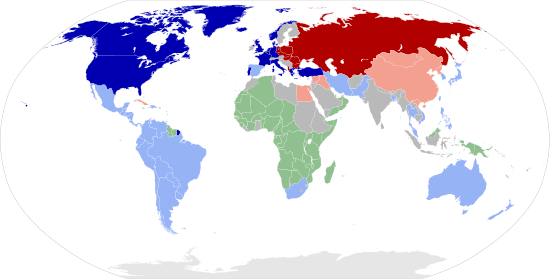 Spheres of influence between the Western world and the Soviet Union during the Cold War. |
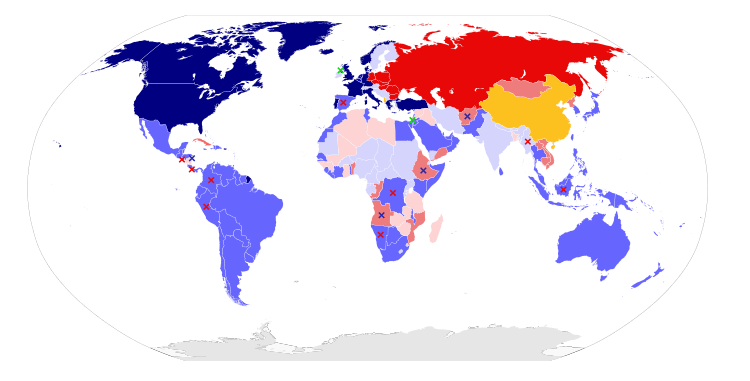 East and West in 1980, as defined by the Cold War. The Cold War had divided Europe politically into East and West, with the Iron Curtain splitting Central Europe. |
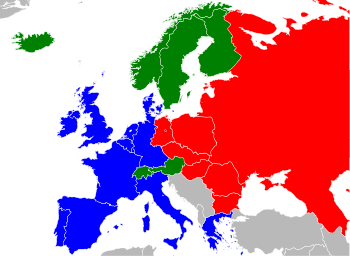 European trade blocs as of 1988. EEC member states are marked in blue, EFTA – green, and Comecon – red. |

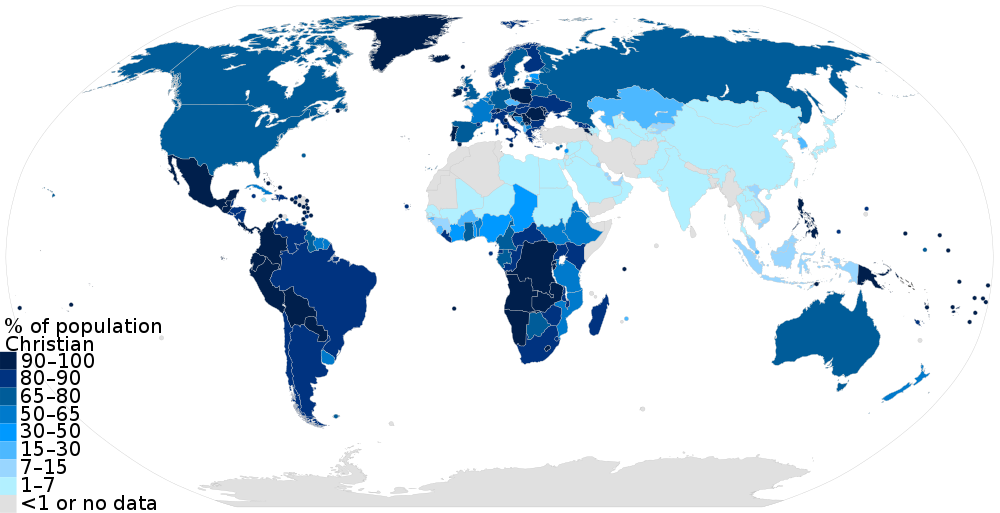
A number of countries did not fit comfortably into this neat definition of partition, including Switzerland, Sweden, Austria, and Ireland, which chose to be neutral. Finland was under the Soviet Union's military sphere of influence (see FCMA treaty) but remained neutral and was not communist, nor was it a member of the Warsaw Pact or Comecon but a member of the EFTA since 1986, and was west of the Iron Curtain. In 1955, when Austria again became a fully independent republic, it did so under the condition that it remain neutral; but as a country to the west of the Iron Curtain, it was in the United States' sphere of influence. Spain did not join the NATO until 1982, seven years after the death of the authoritarian Franco.
Cold War II context
In a debated Cold War II, a new definition emerged inside the realm of western journalism. More specifically, Cold War II,[81] also known as the Second Cold War, New Cold War,[82] Cold War Redux,[83] Cold War 2.0,[84] and Colder War,[85] refers to the tensions, hostilities, and political rivalry that intensified dramatically in 2014 between the Russian Federation on the one hand, and the United States, European Union, NATO and some other countries on the other hand.[81][86] Tensions escalated in 2014 after Russia's annexation of Crimea, military intervention in Ukraine, and the 2015 Russian military intervention in the Syrian Civil War.[87][88][89] By August 2014, both sides had implemented economic, financial, and diplomatic sanctions upon each other: virtually all Western countries, led by the US and EU, imposed restrictive measures on Russia; the latter reciprocally introduced retaliatory measures.[90][91]
Modern definitions
The exact scope of the Western world is somewhat subjective in nature, depending on whether cultural, economic, spiritual or political criteria are employed. It is a generally accepted western view to recognize the existence of at least three "major worlds" (or "cultures", or "civilizations"), broadly in contrast with the Western: the Eastern world, the Arab and the African worlds, with no clearly specified boundaries. Additionally, Latin American and Orthodox worlds are sometimes separately considered "akin" to the West.
Many anthropologists, sociologists and historians oppose "the West and the Rest" in a categorical manner.[92] The same has been done by Malthusian demographers with a sharp distinction between European and non-European family systems. Among anthropologists, this includes Durkheim, Dumont and Lévi-Strauss.[92]
As the term "Western world" does not have a strict international definition, governments do not use the term in legislation of international treaties and instead rely on other definitions.
Cultural definition
In modern usage, Western world refers to Europe and to areas whose populations largely originate from Europe, through the Age of Discovery's imperialism.[15][16]
In the 20th century, Christianity declined in influence in many Western countries, mostly in the European Union where some member states have experienced falling church attendance and membership in recent years,[93] and also elsewhere. Secularism (separating religion from politics and science) increased. However, while church attendance is in decline, in some western countries (i.e. Italy, Poland and Portugal) more than half the people state that religion is important,[94] and most Westerners nominally identify themselves as Christians (e.g. 59% in the United Kingdom) and attend church on major occasions, such as Christmas and Easter. In the Americas, Christianity continues to play an important societal role, though in areas such as Canada, a low level of religiosity is common due to a European-type secularization. The official religions of the United Kingdom and some Nordic countries are forms of Christianity, while the majority of European countries have no official religion. Despite this, Christianity, in its different forms, remains the largest faith in most Western countries.[95]
Christianity remains the dominant religion in the Western world, where 70% are Christians.[96] A 2011 Pew Research Center survey found that 76.2% of Europeans, 73.3% in Oceania, and about 86.0% in the Americas (90% in Latin America and 77.4% in North America) described themselves as Christians.[96][97][98][99]
Western world countries also are the most keen on digital and televisual media technologies, as they were in the postwar period on television and radio: from 2000 to 2014, internet's market penetration in the West was twice that in non-Western regions.[100] Wikipedia is blocked intermittently in China since 2004.[101]
Economic definition
The term "Western world" is sometimes interchangeably used with the term First World or developed countries, stressing the difference between First World and the Third World or developing countries. This usage occurs despite the fact that many countries that may be culturally "Western" are developing countries – in fact, a significant percentage of the Americas are developing countries. It is also used despite many developed countries or regions not being Western (e.g. Japan, Singapore, South Korea, Taiwan, Hong Kong, Macao), and therefore left out when "Western world" is used to denote developed countries. Privatization policies (involving government enterprises and public services) and multinational corporations are often considered a visible sign of Western nations's economic presence, especially in Third World countries, and represent common institutional environment for powerful politicians, enterprises, trade unions and firms, bankers and thinkers of the Western world.[102][103][104][105][106]
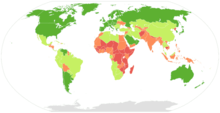
Latin America
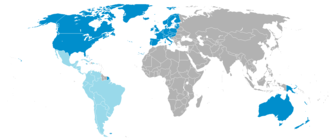
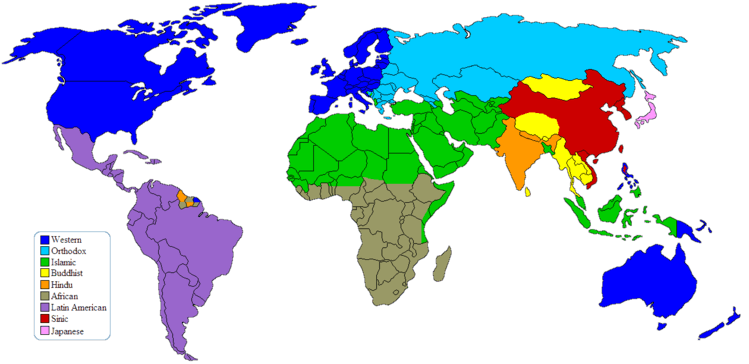
American political scientist, adviser and academic Samuel P. Huntington considered Latin America as separate from the Western world for the purpose of his geopolitical analysis.[107] However, he also states that, while in general researchers consider that the West has three main components (European, North American and Latin American), in his view, Latin America has followed a different development path from Europe and North America. Although it is a scion of European (mainly Spanish and Portuguese) civilization, it also incorporates, to an extent, elements of indigenous American civilizations, absent from North America and Europe. It has had a corporatist and authoritarian culture that Europe had to a much lesser extent. Both Europe and North America felt the effects of the Reformation and combined Catholic and Protestant culture. Historically, Latin America has been only Catholic, although this is changing due to the influx of Protestants into the region. Some regions in Latin America incorporate indigenous cultures, which did not exist in Europe and were effectively annihilated in the United States, and whose importance oscillates between two extremes: Mexico, Central America, Peru and Bolivia, on the one hand, and Argentina and Chile on the other. However, he does mention that the modus operandi of the Catholic Church was to incorporate native elements of pagan European cultures into the general dogma of Catholicism, and the Native American elements could be perceived in the same way.[109] Subjectively, Latin Americans are divided when it comes to identifying themselves. Some say: "Yes, we are part of the West." Others say: "No, we have our own unique culture"; and a vast bibliographical material produced by Latin Americans and North Americans exposes in detail their cultural differences. Huntington goes on to mention that Latin America could be considered a sub-civilization within Western civilization, or a separate civilization intimately related to the West and divided as to its belonging to it. While the second option is the most appropriate and useful for an analysis focused on the international political consequences of civilizations, including relations between Latin America, on the one hand, and North America and Europe, on the other, he also mentions that the underlying conflict of Latin America belonging to the West must eventually be addressed in order to develop a cohesive Latin American identity.[110][111] Huntington's view has, however, been contested on a number of occasions as biased.[112][113]
Views on torn countries
According to Samuel P. Huntington, some countries are torn on whether they are Western or not, with typically the national leadership pushing for Westernization, while historical, cultural and traditional forces remain largely non-Western.[114] These include Turkey, whose political leadership has since the 1920s tried to Westernize the predominantly Muslim country with only 3% of its territory within Europe. It is his chief example of a "torn country" that is attempting to join Western civilization.[107] The country's elite started the Westernization efforts, beginning with Mustafa Kemal Atatürk, who took power as the first president of the modern Turkish nation-state in 1923, imposed western institutions and dress, removed the Arabic alphabet and embraced the Latin alphabet. It joined NATO and since the 1960s has been seeking to join the European Union with very slow progress.[115] Mexico and Russia are also considered to be torn by Huntington. He also gives the example of Australia as a country torn between its Western civilizational heritage and its growing economic engagement with Asia.
Other views
A series of scholars of civilization, including Arnold J. Toynbee, Alfred Kroeber and Carroll Quigley have identified and analyzed "Western civilization" as one of the civilizations that have historically existed and still exist today. Toynbee entered into quite an expansive mode, including as candidates those countries or cultures who became so heavily influenced by the West as to adopt these borrowings into their very self-identity. Carried to its limit, this would in practice include almost everyone within the West, in one way or another. In particular, Toynbee refers to the intelligentsia formed among the educated elite of countries impacted by the European expansion of centuries past. While often pointedly nationalist, these cultural and political leaders interacted within the West to such an extent as to change both themselves and the West.[30]
The theologian and paleontologist Pierre Teilhard de Chardin conceived of the West as the set of civilizations descended from the Nile Valley Civilization of Egypt.[116]
Palestinian-American literary critic Edward Said uses the term occident in his discussion of orientalism. According to his binary, the West, or Occident, created a romanticized vision of the East, or Orient, to justify colonial and imperialist intentions. This Occident-Orient binary focuses on the Western vision of the East instead of any truths about the East. His theories are rooted in Hegel's Master-slave dialectic: The Occident would not exist without the Orient and vice versa. Further, Western writers created this irrational, feminine, weak "Other" to contrast with the rational, masculine, strong West because of a need to create a difference between the two that would justify imperialist ambitions, according to the Said-influenced Indian-American theorist Homi K. Bhabha.
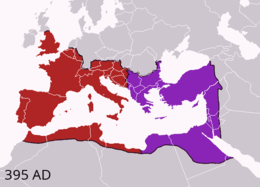 Division of the Roman Empire after 395 into western and eastern part. The geopolitical divisions in Europe that created a concept of East and West originated in the Roman Empire.
Division of the Roman Empire after 395 into western and eastern part. The geopolitical divisions in Europe that created a concept of East and West originated in the Roman Empire.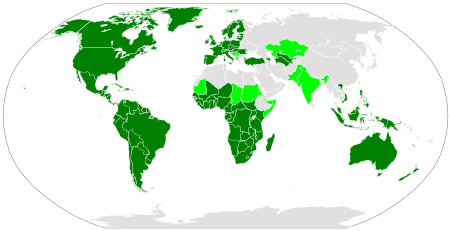 Latin alphabet world distribution. The dark green areas show the countries where this alphabet is the sole official (or de facto official) national script. The light green places show the countries where the alphabet co-exists with other scripts.
Latin alphabet world distribution. The dark green areas show the countries where this alphabet is the sole official (or de facto official) national script. The light green places show the countries where the alphabet co-exists with other scripts. Countries with 50% or more Christians are colored purple while countries with 10% to 50% Christians are colored pink
Countries with 50% or more Christians are colored purple while countries with 10% to 50% Christians are colored pink Map showing relative degree of religiosity by country. Based on a 2006–2008 worldwide survey by Gallup.
Map showing relative degree of religiosity by country. Based on a 2006–2008 worldwide survey by Gallup. Human language families.
Human language families.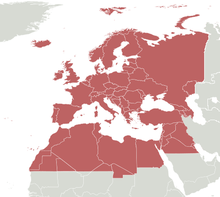 Western Palaearctic, a part of the Palaearctic ecozone, one of the eight ecozones dividing the Earth's surface.
Western Palaearctic, a part of the Palaearctic ecozone, one of the eight ecozones dividing the Earth's surface.- Geopolitical Occident of Europe, according to the Intermediate Region theory of Dimitri Kitsikis

 European Union (in blue) and European Free Trade Association (in green).
European Union (in blue) and European Free Trade Association (in green).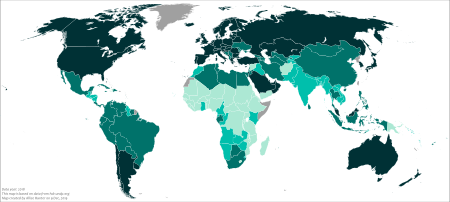 Human Development Index Report (based on 2018 data, published in 2019).
Human Development Index Report (based on 2018 data, published in 2019)..png) Legal systems of the world.
Legal systems of the world. Secular states in blue.
Secular states in blue. Relative geographic prevalence of Christianity versus the second most prevalent religion Islam and lack of either religion, in 2006.
Relative geographic prevalence of Christianity versus the second most prevalent religion Islam and lack of either religion, in 2006.
From a very different perspective, it has also been argued that the idea of the West is, in part, a non-Western invention, deployed in the non-West to shape and define non-Western pathways through or against modernity.[117]
See also
- Americanization
- Anglicisation
- Anglophone
- Atlanticism
- Christendom
- Eastern world
- East-West dichotomy
- Europeanisation
- Far West
- Francophonie
- Free world
- Global North
- Global South
- Golden billion
- Hispanophone
- History of Western civilization
- Mid-Atlantic English
- Monroe Doctrine
- Orient
- Three-world model
- Western esotericism
- Western philosophy
- Westernization
- Western civilization
- Western culture
- Organisations
- European Council
- European Union
- European Economic Area
- Group of Seven (G7)
- North Atlantic Treaty Organization
- Representation in the United Nations
Notes
- Including outermost regions of the European Union such as Madeira and the Canary Islands, which are part of Western European countries despite not being geographically located in Europe.[5]
- Latin America's status as Western is disputed by some researchers.[7]
- See notes:[n 1][n 2][n 3][n 4][n 5][n 6][n 7][n 8][n 9]
See notes [n 10][n 11][n 12][n 13][n 14]The Parthenon, a former temple (Athens, c. 430 BC). The Victorious Youth, a controversial Greek bronze (Greece, c. 300–100 BC). Ancient Theatre of Epidaurus, seats up to 14,000 people (Epidaurus, c. 150 BC). - See notes [n 15][n 16][n 17][n 18][n 19]Pont du Gard, a Roman aqueduct (Vers-Pont-du-Gard, c. 20 BC-AD 50). The Pantheon, a former temple visited—in 2013 alone—by over 6 million people (Rome, c. AD 120). The Aula Palatina, a Roman palace, then a Christian basilica (Trier, c. AD 310).
- Several dates are commonly proposed to mark the transition from Republic to Empire, including the date of Julius Caesar's appointment as perpetual Roman dictator (44 BC), the victory of Caesar's heir Octavian at the Battle of Actium (2, 31 September BC), and the Roman Senate's granting to Octavian the honorific Augustus. (16, 27 January BC). Octavian/Augustus officially proclaimed that he had saved the Roman Republic and carefully disguised his power under republican forms: Consuls continued to be elected, tribunes of the plebeians continued to offer legislation, and senators still debated in the Roman Curia. However, it was Octavian who influenced everything and controlled the final decisions, and in final analysis, had the legions to back him up, if it became necessary.
- Others have fiercely criticized these views arguing they confuse the Eastern Roman Empire with Russia, especially considering the fact that the country that had the most historical roots in Byzantium (Greece) expelled communists and was allied with the West during the Cold War. Still, Russia accepted Eastern Christianity from the Byzantine Empire (by the Patriarch of Constantinople: Photios I) linking Russia very close to the Eastern Roman Empire world. Later on, in 16th century Russia created its own religious centre in Moscow. Religion survived in Russia beside severe persecution carrying values alternative to the communist ideology.
- The Dalmatia remained under Venice domination throughout next centuries (even constituting an Italian territorial claim by the Treaty of Versailles in the aftermath of the First World War and through successive Italy's fascist period's demands).
- These changes were adopted by the Scandinavian kings. Later, French commoner Jean Cauvin (John Calvin) assumed the religio-political leadership in Geneva, a former ecclesiastical city whose prior ruler had been the bishop. The English king later improvised on the Lutheran model, but subsequently many Calvinist doctrines were adopted by popular dissenters paralleling the struggles between the King and Parliament lead to the English Civil War (1642–1651) between royalists and parliamentarians, while both colonized North America eventually resulting in an independent United States of America (1776) during the Industrial Revolution.
- Portuguese sailors began exploring the coast of Africa and the Atlantic archipelagos in 1418–19, using recent developments in navigation, cartography and maritime technology such as the caravel, in order that they might find a sea route to the source of the lucrative spice trade. In 1488, Bartolomeu Dias rounded the southern tip of Africa under the sponsorship of Portugal's John II, from which point he noticed that the coast swung northeast (Cape of Good Hope). In 1492 Christopher Columbus would land on an island in the Bahamas archipelago on behalf of the Spanish, and documenting the Atlantic Ocean's routes would be granted a Coat of Arms by Pope Alexander VI motu proprio in 1502. In 1497 Portuguese navigator Vasco da Gama made the first open voyage from Europe to India. In 1520, Ferdinand Magellan, a Portuguese navigator in the service of the Crown of Castile ('Spain'), found a sea route into the Pacific Ocean.
- In the 16th century, the Portuguese broke the (overland) Medieval monopoly of the Arabs and Italians of trade (goods and slaves) between Asia and Europe by the discovery of the sea route to India around the Cape of Good Hope.[63] With the ensuing rise of the rival Dutch East India Company, Portuguese influence in Asia was gradually eclipsed; Dutch forces first established fortified independent bases in the East and then between 1640 and 1660 wrestled some southern Indian ports, and the lucrative Japan trade from the Portuguese. Later, the English and the French established some settlements in India and trade with China, and their own acquisitions would gradually surpass those of the Dutch. In 1763, the British eliminated French influence in India and established the British East India Company as the most important political force on the Indian Subcontinent.
- Although Christianized by early Middle Ages, Ireland is soon colonised in 16th- and 17th-century with settlers from the neighboring island of Great Britain (several people committed in the establishment of these colonies in Ireland, would later also colonise North America initiating the British Empire), while Iceland still uninhabited long after the rest of Western Europe had been settled, by 1397–1523 would eventually be united in one alliance with all of the Nordic states (kingdoms of Denmark, Sweden and Norway).
- The Scramble for Africa was the occupation, division, and colonization of African territory by European powers during the period of New Imperialism, between 1881 and 1914. It is also called the 'Partition of Africa' and by some the 'Conquest of Africa'. In 1870, only 10 percent of Africa was under formal Western/European control; by 1914 it had increased to almost 90 percent of the continent, with only Ethiopia (Abyssinia), the Dervish state (a portion of present-day Somalia)[69] and Liberia still being independent.
- In ancient Greece (8th century BC – AD 6th century), hegemony denoted the politico-military dominance of a city-state over other city-states.[70] The dominant state is known as the hegemon.[71]
- Ricardo Duchesne (7 February 2011). The Uniqueness of Western Civilization. BRILL. p. 297. ISBN 978-90-04-19248-5.
The list of books which have celebrated Greece as the "cradle" of the West is endless; two more examples are Charles Freeman's The Greek Achievement: The Foundation of the Western World (1999) and Bruce Thornton's Greek Ways: How the Greeks Created Western Civilization (2000)
- Chiara Bottici; Benoît Challand (11 January 2013). The Myth of the Clash of Civilizations. Routledge. p. 88. ISBN 978-1-136-95119-0.
The reason why even such a sophisticated historian as Pagden can do it is that the idea that Greece is the cradle of civilisation is so much rooted in western minds and school curicula as to be taken for granted.
- William J. Broad (2007). The Oracle: Ancient Delphi and the Science Behind Its Lost Secrets. Penguin Publishing Group. p. 120. ISBN 978-0-14-303859-7.
In 1979, a friend of de Boer's invited him to join a team of scientists that was going to Greece to assess the suitability of the ... But the idea of learning more about Greece — the cradle of Western civilization, a fresh example of tectonic forces at ...
- Maura Ellyn; Maura McGinnis (2004). Greece: A Primary Source Cultural Guide. The Rosen Publishing Group. p. 8. ISBN 978-0-8239-3999-2.
- John E. Findling; Kimberly D. Pelle (2004). Encyclopedia of the Modern Olympic Movement. Greenwood Publishing Group. p. 23. ISBN 978-0-313-32278-5.
- Wayne C. Thompson; Mark H. Mullin. Western Europe, 1983. Stryker-Post Publications. p. 337.
for ancient Greece was the cradle of Western culture ...
- Frederick Copleston (1 June 2003). History of Philosophy Volume 1: Greece and Rome. A&C Black. p. 13. ISBN 978-0-8264-6895-6.
PART I PRE-SOCRATIC PHILOSOPHY CHAPTER II THE CRADLE OF WESTERN THOUGHT:
- Mario Iozzo (2001). Art and History of Greece: And Mount Athos. Casa Editrice Bonechi. p. 7. ISBN 978-88-8029-435-1.
The capital of Greece, one of the world's most glorious cities and the cradle of Western culture,
- Marxiano Melotti (25 May 2011). The Plastic Venuses: Archaeological Tourism in Post-Modern Society. Cambridge Scholars Publishing. p. 188. ISBN 978-1-4438-3028-7.
In short, Greece, despite having been the cradle of Western culture, was then an “other” space separate from the West.
- Library Journal. 97. Bowker. April 1972. p. 1588.
Ancient Greece: Cradle of Western Culture (Series), disc. 6 strips with 3 discs, range: 44–60 fr., 17–18 min
- Stanley Mayer Burstein (2002). Current Issues and the Study of Ancient History. Regina Books. p. 15. ISBN 978-1-930053-10-6.
and making Egypt play the same role in African education and culture that Athens and Greece do in Western culture.
- Murray Milner, Jr. (8 January 2015). Elites: A General Model. John Wiley & Sons. p. 62. ISBN 978-0-7456-8950-0.
Greece has long been considered the seedbed or cradle of Western civilization.
- Slavica viterbiensia 003: Periodico di letterature e culture slave della Facoltà di Lingue e Letterature Straniere Moderne dell'Università della Tuscia. Gangemi Editore spa. 10 November 2011. p. 148. ISBN 978-88-492-6909-3.
The Special Case of Greece The ancient Greece was a cradle of the Western culture,
- Kim Covert (1 July 2011). Ancient Greece: Birthplace of Democracy. Capstone. p. 5. ISBN 978-1-4296-6831-6.
Ancient Greece is often called the cradle of western civilization. ... Ideas from literature and science also have their roots in ancient Greece.
- Henry Turner Inman. Rome: the cradle of western civilisation as illustrated by existing monuments. ISBN 9781177738538.
- Michael Ed. Grant (1964). The Birth Of Western Civilisation, Greece & Rome. Amazon.co.uk. Thames & Hudson. Retrieved 4 January 2016.
- HUXLEY, George; et al. "9780500040034: The Birth of Western Civilization: Greece and Rome". AbeBooks.com. Retrieved 4 January 2016.
- "Athens. Rome. Jerusalem and Vicinity. Peninsula of Mt. Sinai.: Geographicus Rare Antique Maps". Geographicus.com. Retrieved 4 January 2016.
- "Download This PDF eBooks Free" (PDF). File104.filthbooks.org. Archived from the original (PDF) on 7 January 2016. Retrieved 4 January 2016.
References
- THE WORLD OF CIVILIZATIONS: POST-1990 scanned image Archived 12 March 2007 at the Wayback Machine
- Huntington, Samuel P. (1991). Clash of Civilizations (6th ed.). Washington, DC. pp. 38–39. ISBN 978-0-684-84441-1 – via http://www.mercaba.org/SANLUIS/Historia/Universal/Huntington,%20Samuel%20-%20El%20choque%20de%20civilizaciones.pdf (in Spanish).
The origin of western civilization is usually dated to 700 or 800 AD. In general, researchers consider that it has three main components, in Europe, North America and Latin America. [...] However, Latin America has followed a quite different development path from Europe and North America. Although it is a scion of European civilization, it also incorporates more elements of indigenous American civilizations compared to those of North America and Europe. It also currently has had a more corporatist and authoritarian culture. Both Europe and North America felt the effects of Reformation and combination of Catholic and Protestant cultures. Historically, Latin America has been only Catholic, although this may be changing. [...] Latin America could be considered, or a sub-set, within Western civilization, or can also be considered a separate civilization, intimately related to the West, but divided as to whether it belongs with it.
- Huntington, Samuel P. (2 August 2011). The Clash of Civilizations and the Remaking of World Order. Simon & Schuster. pp. 151–154. ISBN 978-1451628975.
- Huntington, Samuel P. (1991). Clash of Civilizations (6th ed.). Washington, DC. pp. 42. ISBN 978-0-684-84441-1 – via http://www.mercaba.org/SANLUIS/Historia/Universal/Huntington,%20Samuel%20-%20El%20choque%20de%20civilizaciones.pdf (in Spanish).
- "Western Countries 2020". 4 June 2020.
- Western Civilization, Our Tradition; James Kurth; accessed 30 August 2011
- Espinosa, Emilio Lamo de (4 December 2017). "Is Latin America part of the West?" (PDF). Elcano Royal Institute.
- Questions about immigrant-related statistics. "Key figures Immigration and immigrants – SSB". Ssb.no. Retrieved 15 December 2015.
- Innvandrere og norskfødte med innvandrerforeldre, 1. januar 2015 Statistics Norway (in Norwegian) retrieved 15 December 2015
- Role of Judaism in Western culture and civilization, "Judaism has played a significant role in the development of Western culture because of its unique relationship with Christianity, the dominant religious force in the West". Judaism at Encyclopædia Britannica
- "Western culture". Science Daily.
- "A brief history of Western culture". Khan Academy.
- Bideleux, Robert; Jeffries, Ian (1998). A history of eastern Europe: crisis and change. Routledge. p. 48. ISBN 978-0-415-16112-1.
- Western Civilization, Our Tradition; James Kurth; accessed 30 August 2011
- Thompson, William; Hickey, Joseph (2005). Society in Focus. Boston, MA: Pearson. 0-205-41365-X.
- Gregerson, Linda; Juster, Susan (2011). Empires of God: Religious Encounters in the Early Modern Atlantic. University of Pennsylvania Press. ISBN 978-0812222609. Retrieved 28 June 2018.
- Jackson J. Spielvogel (14 September 2016). Western Civilization: Volume A: To 1500. Cengage Learning. pp. 32–. ISBN 978-1-337-51759-1.
- Religions in Global Society – Page 146, Peter Beyer – 2006
- Cambridge University Historical Series, An Essay on Western Civilization in Its Economic Aspects, p.40: Hebraism, like Hellenism, has been an all-important factor in the development of Western Civilization; Judaism, as the precursor of Christianity, has indirectly had had much to do with shaping the ideals and morality of western nations since the christian era.
- "The Evolution of Civilizations – An Introduction to Historical Analysis (1979)". 10 March 2001. p. 84. Retrieved 31 January 2014.
- Middle Ages "Of the three great civilizations of Western Eurasia and North Africa, that of Christian Europe began as the least developed in virtually all aspects of material and intellectual culture, well behind the Islamic states and Byzantium."
- H. G. Wells, The Outline of History, Section 31.8, The Intellectual Life of Arab Islam "For some generations before Muhammad, the Arab mind had been, as it were, smouldering, it had been producing poetry and much religious discussion; under the stimulus of the national and racial successes it presently blazed out with a brilliance second only to that of the Greeks during their best period. From a new angle and with a fresh vigour it took up that systematic development of positive knowledge, which the Greeks had begun and relinquished. It revived the human pursuit of science. If the Greek was the father, then the Arab was the foster-father of the scientific method of dealing with reality, that is to say, by absolute frankness, the utmost simplicity of statement and explanation, exact record, and exhaustive criticism. Through the Arabs it was and not by the Latin route that the modern world received that gift of light and power."
- Lewis, Bernard (2002). What Went Wrong. Oxford University Press. p. 3. ISBN 978-0-06-051605-5. "For many centuries the world of Islam was in the forefront of human civilization and achievement ... In the era between the decline of antiquity and the dawn of modernity, that is, in the centuries designated in European history as medieval, the Islamic claim was not without justification."
- "Science, civilization and society". Es.flinders.edu.au. Retrieved 6 May 2011.
- Richard J. Mayne, Jr. "Middle Ages". Britannica.com. Retrieved 6 May 2011.
- InfoPlease.com, commercial revolution
- "The Scientific Revolution". Wsu.edu. 6 June 1999. Archived from the original on 1 May 2011. Retrieved 6 May 2011.
- Eric Bond; Sheena Gingerich; Oliver Archer-Antonsen; Liam Purcell; Elizabeth Macklem (17 February 2003). "Innovations". The Industrial Revolution. Retrieved 6 May 2011.
- "How Islam Created Europe; In late antiquity, the religion split the Mediterranean world in two. Now it is remaking the Continent". TheAtlantic.com. May 2016. Retrieved 25 April 2016.
- Cf., Arnold J. Toynbee, Change and Habit. The challenge of our time (Oxford 1966, 1969) at 153–56; also, Toynbee, A Study of History (10 volumes, 2 supplements).
- Alexander Lukin. Russia Between East and West: Perceptions and Reality Archived 13 November 2017 at the Wayback Machine. Brookings Institution. Published on 28 March 2003
- Duran 1995, p.81
- Sri Aurobindo, "Ideal of Human Unity" included in Social and Political Thought, 1970.
- Charles Freeman. The Closing of the Western Mind. Knopf, 2003. ISBN 1-4000-4085-X
- Karin Friedrich et al., The Other Prussia: Royal Prussia, Poland and Liberty, 1569–1772, Cambridge University Press, 2000, ISBN 0-521-58335-7, Google Print, p. 88
- St Jerome, Letter CXXVII. To Principia, s:Nicene and Post-Nicene Fathers: Series II/Volume VI/The Letters of St. Jerome/Letter 127 paragraph 12.
- Dominic Selwood, "On this day in AD 455: the beginning of the end for Rome" 2 June 2017.
- Irina-Maria Manea, "Alaric, Barbarians and Rome: a Complicated Relationship".
- Rodney Stark, "How the West Won: The Neglected Story of the Triumph of Modernity".
- Dragan Brujić (2005). "Vodič kroz svet Vizantije (Guide to the Byzantine World)". Beograd. p. 51.
- Setton, Kenneth Meyer, ed. (1969). A History of the Crusades. Wisconsin University Press. pp. 209–210. ISBN 9780299048341.
- Dulles S.J., Avery (2012). Reno, R.R. (ed.). The Orthodox Imperative: Selected Essays of Avery Cardinal Dulles, S.J. (Kindle ed.). First Things Press. p. 224.
- Wolff, R. L. (1969). "V: The Fourth Crusade". In Hazard, H. W. (ed.). The later Crusades, 1189–1311. University of Wisconsin Press. p. 162. Retrieved 9 November 2013.
- Phillips, The Fourth Crusade and the Sack of Constantinople, Introduction, xiii.
- Goldstein, I. (1999). Croatia: A History. McGill-Queen's University Press.
- "CATHOLIC ENCYCLOPEDIA: Inquisition". Newadvent.org. Retrieved 13 October 2017.
-
Lea, Henry Charles (1888). "Chapter VII. The Inquisition Founded". A History of the Inquisition In The Middle Ages. 1. ISBN 1-152-29621-3.
The judicial use of torture was as yet happily unknown...
- Foxe, John. "Chapter V" (PDF). Foxe's Book of Martyrs.
-
Blötzer, J. (1910). "Inquisition". The Catholic Encyclopedia. Robert Appleton Company. Retrieved 26 August 2012.
... in this period the more influential ecclesiastical authorities declared that the death penalty was contrary to the spirit of the Gospel, and they themselves opposed its execution. For centuries this was the ecclesiastical attitude both in theory and in practice. Thus, in keeping with the civil law, some Manichæans were executed at Ravenna in 556. On the other hand, Elipandus of Toledo and Felix of Urgel, the chiefs of Adoptionism and Predestinationism, were condemned by councils, but were otherwise left unmolested. We may note, however, that the monk Gothescalch, after the condemnation of his false doctrine that Christ had not died for all mankind, was by the Synods of Mainz in 848 and Quiercy in 849 sentenced to flogging and imprisonment, punishments then common in monasteries for various infractions of the rule.
-
Blötzer, J. (1910). "Inquisition". The Catholic Encyclopedia. Robert Appleton Company. Retrieved 26 August 2012.
[...] the occasional executions of heretics during this period must be ascribed partly to the arbitrary action of individual rulers, partly to the fanatic outbreaks of the overzealous populace, and in no wise to ecclesiastical law or the ecclesiastical authorities.
- Lea, Henry Charles. "Chapter VII. The Inquisition Founded". A History of the Inquisition In The Middle Ages. 1. ISBN 1-152-29621-3.
- "Background to Against the Sale of Indulgences by Martin Luther". Wcupa.edu. West Chester University of Pennsylvania. 2012.
- "How important was the role of the princes in bringing about the success of the Lutheran Reformation in Germany in the years 1525 to 1555?". markedbyteachers.com. Marked by Teachers. 2009.
- "The Reformation". history.com. A&E Television Networks.
- Henry Kissinger (2014). "Introduction and Chpt 1". World Order: Reflections on the Character of Nations and the Course of History. Allen Lane. ISBN 978-0241004265.
- "The 6 killer apps of prosperity". Ted.com. 11 August 2017. Retrieved 11 August 2017.
- "Modern West Civ. 7: The Scientific Revolution of the 17 Cent". Fordham.edu. Retrieved 6 May 2011.
- "The Industrial Revolution". Mars.wnec.edu. Archived from the original on 14 December 2000. Retrieved 6 May 2011.
- Industrial Revolution and the Standard of Living: The Concise Encyclopedia of Economics, Library of Economics and Liberty
- Daus 1983, p. 33
- "Columbus Monuments Pages: Valladolid". Retrieved 3 January 2010.
- Samuel Eliot Morison, Admiral of the Ocean Sea: The Life of Christopher Columbus, (Boston: Atlantic-Little, Brown, 1942). Reissued by the Morison Press, 2007. ISBN 1-4067-5027-1
- M. Weisner-Hanks, Early Modern Europe 1450–1789 (Cambridge, 2006)
- Ferguson, Niall (2004). Empire: The Rise and Demise of the British World Order and the Lessons for Global Power. New York: Basic Books. p. 62. ISBN 978-0-465-02329-5.
- "The World at Six Billion". United Nations. 12 October 1999. Retrieved 1 August 2010.
- Wim Van Den Doel (2010). The Dutch Empire. An Essential Part of World History. BMGN – Low Countries Historical Review.
The Western belief in progress, Enlightenment thinking and the scientific revolution were elements that enabled the Western economy to develop in the nineteenth century in a way that was fundamentally different from most of the economies in the rest of the world. Europeans had not been able to sell much to the Asians in the sixteenth, seventeenth and eighteenth centuries, but after the Industrial Revolution the situation was completely different, and the European textile industry, for example, was easily able to sell its cheap products throughout Asia. Improved transport methods also meant that European products could reach the Asian market at a relatively low cost. From about 1800, what historians term ‘the great divergence’ took place, which was the separation of the economic development of the Western World, on the one hand, and of almost all of Asia and Africa on the other.
-
Webster, Richard A. "European expansion since 1763". ENCYCLOPÆDIA BRITANNICA. Encyclopædia Britannica. Retrieved 23 July 2018.
The global expansion of western Europe between the 1760s and the 1870s differed in several important ways from the expansionism and colonialism of previous centuries. Along with the rise of the Industrial Revolution, which economic historians generally trace to the 1760s, and the continuing spread of industrialization in the empire-building countries came a shift in the strategy of trade with the colonial world. Instead of being primarily buyers of colonial products (and frequently under strain to offer sufficient salable goods to balance the exchange), as in the past, the industrializing nations increasingly became sellers in search of markets for the growing volume of their machine-produced goods.
- "European expansion since 1763". Encyclopædia Britannica. Retrieved 4 August 2018.
- Camille Pecastaing, Jihad in the Arabian Sea (Stanford: Hoover Institution Press, 2011), In the land of the Mad Mullah: Somalia
- Chernow, Barbara A.; Vallasi, George A., eds. (1994). The Columbia Encyclopedia (Fifth ed.). New York: Columbia University Press. p. 1215. ISBN 0-231-08098-0.
- Oxford English Dictionary: "A leading or paramount power; a dominant state or person"
- Kevin Shillington, History of Africa. Revised second edition (New York: Macmillan Publishers Limited, 2005), 301.
- Maddison 2001, pp. 97 "The total population of the Empire was 412 million [in 1913]", 241 "[World population in 1913 (in thousands):] 1 791 020".
- Rein Taagepera (September 1997). "Expansion and Contraction Patterns of Large Polities: Context for Russia". International Studies Quarterly. 41 (3): 502. doi:10.1111/0020-8833.00053. JSTOR 2600793.
- "The World Factbook — Central Intelligence Agency". www.cia.gov. Retrieved 10 September 2016.
land: 148.94 million sq km
- Jackson, pp. 5–6.
- Zamora, Stephen. "Review of Global Reach: the Power of the Multinational Corporations, by Richard J. Barnet and Ronald E. Muller". Catholic University Law Review. 26 (2 Winter 1977): 449–456.
- R. Vernon, Sovereignty at Bay: the Multinational Spread of U.S. Enterprises (1971).
- "Securing the World's Commercial Sea Lanes | The American Spectator | Politics Is Too Important To Be Taken Seriously". The American Spectator. Retrieved 13 November 2019.
- ANALYSIS (19 December 2011). "Table: Religious Composition by Country, in Percentages". Pewforum.org. Retrieved 17 August 2012.
- Dmitri Trenin (4 March 2014). "Welcome to Cold War II". Foreign Policy. Graham Holdings. Retrieved 4 February 2015.
- Simon Tisdall (19 November 2014). "The new cold war: are we going back to the bad old days?". The Guardian. Guardian News and Media Limited. Retrieved 4 February 2015.
- Laudicina, Paul (15 May 2014). "Ukraine: Cold War Redux Or New Global Challenge?". Forbes. Retrieved 9 January 2015.
- Eve Conant (12 September 2014). "Is the Cold War Back?". National Geographic. National Geographic Society. Retrieved 4 February 2015.
- Mauldin, John (29 October 2014). "The Colder War Has Begun". Forbes. Retrieved 22 December 2014.
- As Cold War II Looms, Washington Courts Nationalist, Rightwing, Catholic, Xenophobic Poland, Huffington Post, 15 October 2015.
- "'The Cold War never ended...Syria is a Russian-American conflict' says Bashar al-Assad". The Telegraph. 14 October 2016. Retrieved 24 January 2017.
- "U.S. Weaponry Is Turning Syria Into Proxy War With Russia". The New York Times. 12 October 2015. Retrieved 14 October 2015.
- "U.S., Russia escalate involvement in Syria". CNN. 13 October 2015. Retrieved 17 October 2015.
- "U.S. and other powers kick Russia out of G8". CNN.com. 25 March 2014. Retrieved 7 August 2014.
- Johanna Granville, "The Folly of Playing High-Stakes Poker with Putin: More to Lose than Gain over Ukraine." 8 May 2014.
- "New Left Review – Jack Goody: The Labyrinth of Kinship". Retrieved 24 July 2007.
- Ford, Peter (22 February 2005). "What place for God in Europe". USA Today. Retrieved 24 July 2009.
- Eurostat (2005). "Social values, Science and Technology" (PDF). Special Eurobarometer 225. Europa, web portal: 9. Retrieved 11 June 2009.
- See ARDA data archives: http://www.thearda.com/internationalData/regions/index.asp
- ANALYSIS (19 December 2011). "Global Christianity". Pewforum.org. Retrieved 17 August 2012.
- ANALYSIS (19 December 2011). "Europe". Pewforum.org. Retrieved 17 August 2012.
- ANALYSIS (19 December 2011). "Americas". Pewforum.org. Retrieved 17 August 2012.
- ANALYSIS (19 December 2011). "Global religious landscape: Christians". Pewforum.org. Retrieved 17 August 2012.
- Maurice Roche (2017). Mega-Events and Social Change: Spectacle, Legacy and Public Culture. Oxford University Press. p. 329. ISBN 9781526117083.
- Reid, David (15 May 2019). "China blocks Wikipedia in all languages". CNBC. Retrieved 23 May 2019.
- Paul Starr, "The Meaning of Privatization," Yale Law and Policy Review 6: 6–41" 1988.
- James C. W. Ahiakpor, "Multinational Corporations in the Third World: Predators or Allies in Economic Development?" 20 July 2010.
- Investopedia, "Why are most multinational corporations either from the US, Europe or Japan".
- Jackson J. Spielvogel, "Western Civilization: A Brief History, Volume II: Since 1500" 2016.
- United States. Congress. Senate. Committee on Foreign Relations. Subcommittee on Multinational Corporations, "Multinational corporations and United States foreign policy Part 11" 1975.
- THE WORLD OF CIVILIZATIONS: POST-1990 scanned image Archived 12 March 2007 at the Wayback Machine
- Huntington, Samuel P. (1991). Clash of Civilizations (6th ed.). Washington, DC. pp. 38–39. ISBN 978-0-684-84441-1 – via http://www.mercaba.org/SANLUIS/Historia/Universal/Huntington,%20Samuel%20-%20El%20choque%20de%20civilizaciones.pdf (in Spanish).
The origin of western civilization is usually dated to 700 or 800 AD. In general, researchers consider that it has three main components, in Europe, North America and Latin America. [...] However, Latin America has followed a quite different development path from Europe and North America. Although it is a scion of European civilization, it also incorporates, to varying degrees, elements of indigenous American civilizations, absent from North America and Europe. It has had a corporatist and authoritarian culture that Europe had to a much lesser extent and America did not have at all. Both Europe and North America felt the effects of the Reformation and combined Catholic and Protestant culture. Historically, Latin America has been only Catholic, although this may be changing. [...] Latin America could be considered, or a sub-civilization within Western civilization, or a separate civilization, intimately related to the West and divided as to its belonging to it. [...] For an analysis focused on the international political consequences of civilizations, including relations between Latin America, on the one hand, and North America and Europe, on the other, the second option is the most appropriate and useful.
- Huntington, Samuel P. (1991). Clash of Civilizations (6th ed.). Washington, DC. pp. 110–111. ISBN 978-0-684-84441-1 – via http://www.mercaba.org/SANLUIS/Historia/Universal/Huntington,%20Samuel%20-%20El%20choque%20de%20civilizaciones.pdf (in Spanish).
- Huntington, Samuel P. (1991). Clash of Civilizations (6th ed.). Washington, DC. pp. 38–39. ISBN 978-0-684-84441-1 – via http://www.mercaba.org/SANLUIS/Historia/Universal/Huntington,%20Samuel%20-%20El%20choque%20de%20civilizaciones.pdf (in Spanish).
The origin of western civilization is usually dated to 700 or 800 AD. In general, researchers consider that it has three main components, in Europe, North America and Latin America"... "However, Latin America has followed a quite different development path from Europe and North America. Although it is a scion of European civilization, it also incorporates, to varying degrees, elements of indigenous American civilizations, absent from North America and Europe. It has had a corporatist and authoritarian culture that Europe had to a much lesser extent and America did not have at all. Both Europe and North America felt the effects of the Reformation and combined Catholic and Protestant culture. Historically, Latin America has been only Catholic, although this may be changing. Latin American civilization incorporates indigenous cultures, which did not exist in Europe, which were effectively annihilated in North America, and whose importance oscillates between two extremes: Mexico, Central America, Peru and Bolivia, on the one hand, and Argentina and Chile, on the other. The political evolution and the economic development of Latin America have clearly separated from the predominant models in the North Atlantic countries. Subjectively, Latin Americans themselves are divided when it comes to identifying themselves. Some say: "Yes, we are part of the West." Others say: "No, we have our own unique culture"; and a vast bibliographical material produced by Latin Americans and North Americans exposes in detail their cultural differences. Latin America could be considered, or a sub-civilization within Western civilization, or a separate civilization, intimately related to the West and divided as to its belonging to it.
- Huntington, Samuel P. (1991). Clash of Civilizations (6th ed.). Washington, DC. pp. 148–150. ISBN 978-0-684-84441-1 – via http://www.mercaba.org/SANLUIS/Historia/Universal/Huntington,%20Samuel%20-%20El%20choque%20de%20civilizaciones.pdf (in Spanish).
- Fuentes, Carlos. "Huntington and the Mask of Racism". NPQ.
- Citrin, Jack; Lerman, Amy; Murakami, Michael; Pearson, Kathryn (2007). "Testing Huntington: Is Hispanic Immigration a Threat to American Identity?" (PDF). Perspectives on Politics. 5 (1): 31–48. doi:10.1017/s1537592707070041.
- Huntington, Samuel (1996). The Clash of Civilizations and the Remaking of World Order. New York: Simon & Schuster. p. 43.
- Samuel P. Huntington. The Clash of Civilizations and the Remaking of World Order. The Free Press. pp. 144–149.
- Cf., Teilhard de Chardin, Le Phenomene Humain (1955), translated as The Phenomena of Man (New York 1959).
- Bonnett, A. 2004. The Idea of the West
Further reading
- Ankerl, Guy (2000). Coexisting contemporary civilizations: Arabo-Muslim, Bharati, Chinese, and West. INU societal research. 1. Global communication without universal civilization. Geneva: INU Press. ISBN 2-88155-004-5.
- Bavaj, Riccardo: "The West": A Conceptual Exploration , European History Online, Mainz: Institute of European History, 2011, retrieved: 28 November 2011.
- Daly, Jonathan. "The Rise of Western Power: A Comparative History of Western Civilization" (London and New York: Bloomsbury, 2014). ISBN 9781441161314.
- Daly, Jonathan. "Historians Debate the Rise of the West" (London and New York: Routledge, 2015). ISBN 978-1-13-877481-0.
- The Western Tradition homepage at Annenberg/CPB – where you can watch each episode on demand for free (Pop-ups required)
- J. F. C. Fuller. A Military History of the Western World. Three Volumes. New York: Da Capo Press, Inc., 1987 and 1988.
- V. 1. From the earliest times to the Battle of Lepanto; ISBN 0-306-80304-6.
- V. 2. From the defeat of the Spanish Armada to the Battle of Waterloo; ISBN 0-306-80305-4.
- V. 3. From the American Civil War to the end of World War II; ISBN 0-306-80306-2.
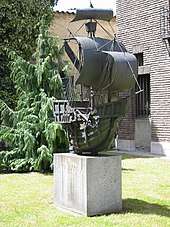
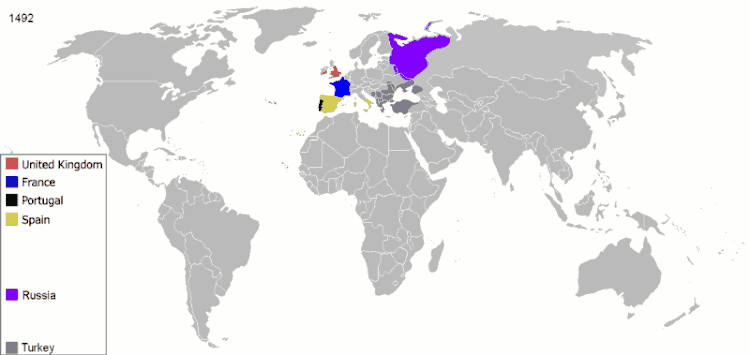

.svg.png)
.svg.png)
.svg.png)

